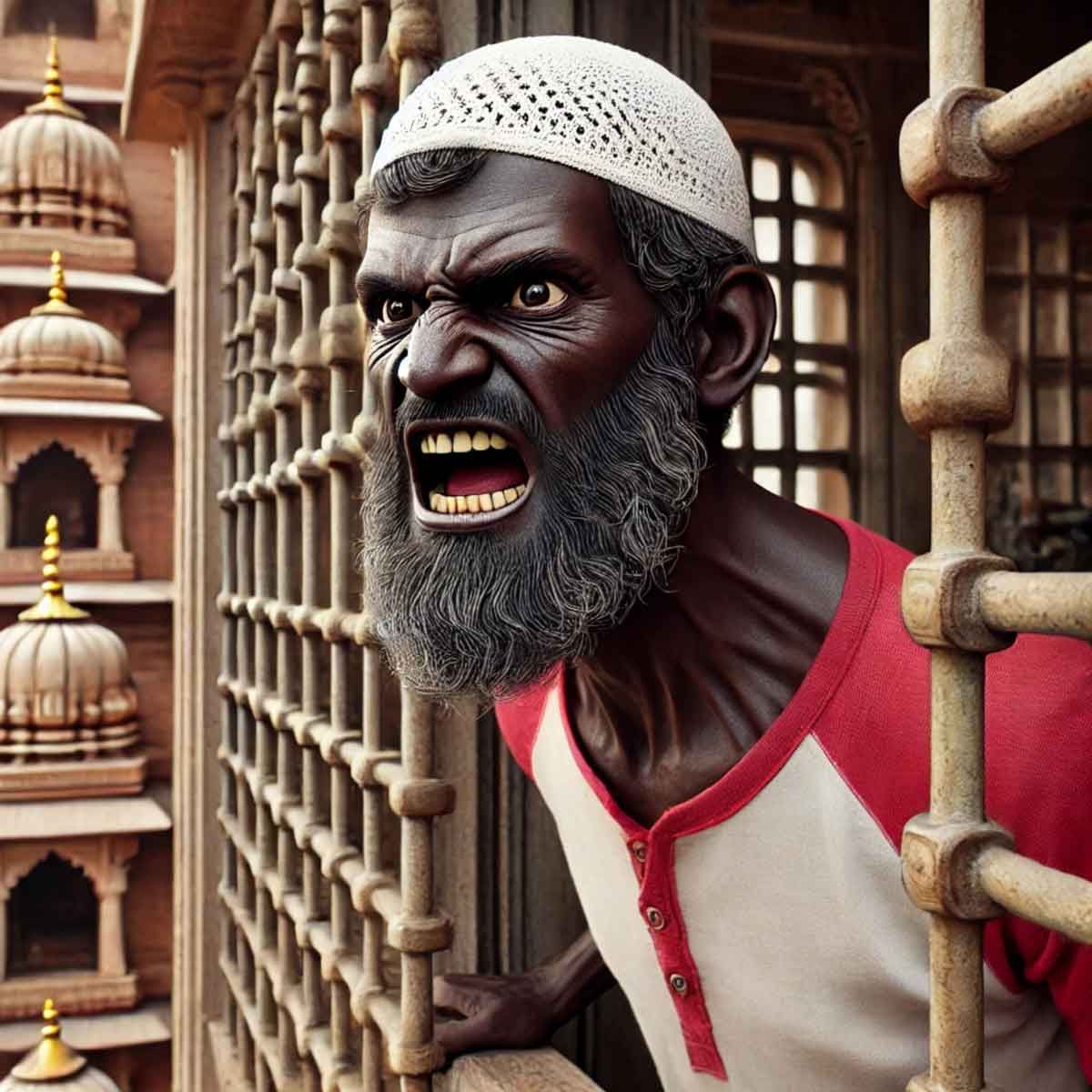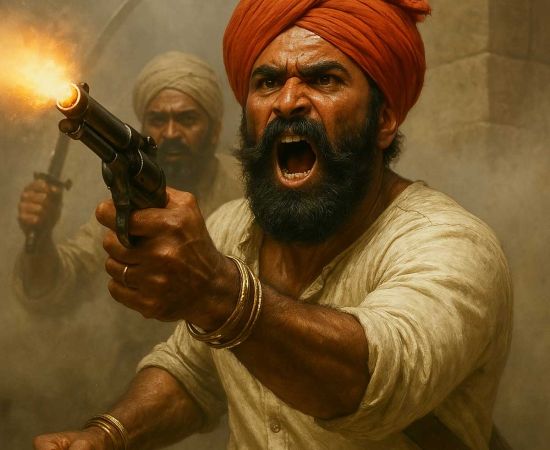MORE COVERAGE
Twitter Coverage
Satyaagrah
Written on
Satyaagrah
Written on
Satyaagrah
Written on
Satyaagrah
Written on
Satyaagrah
Written on
JOIN SATYAAGRAH SOCIAL MEDIA
"चलाक मंदबुद्धि": Muslim man Sher Khan pelts stones at Ram Temple, threatens Mahant, claiming the temple belongs to Muslims; Mahant Arun Chaudhary asserts Sher Khan is faking mental instability, only targeting Hindus and making a fool out of everyone

In a disturbing incident from Mathura district in Uttar Pradesh, a young Muslim man named Sher Khan created a tense situation on Monday morning, 23rd September. Sher Khan barged into a prominent Hindu temple, the Ram Mandir, located near Retia Bazaar, under the jurisdiction of the Raya Police Station. The incident has sparked concern among the local Hindu community, as it involved not only a physical attack but also severe threats aimed at the temple's religious leader.
|
According to reports, Sher Khan didn't just trespass into the temple; he went on to threaten Mahant Arun Chaudhary, the head priest of the Ram Mandir. His aggressive behavior escalated as he allegedly hurled stones at the temple and even launched a direct assault on the Mahant. The nature of his threats was particularly alarming as he demanded that the Mahant refrain from opening the temple and vacate the premises, boldly declaring that the temple and the land it stands on belonged to Muslims.
The local community is deeply unsettled by Sher Khan's actions, especially in light of his claim that the temple should not be reopened. The incident has raised questions about the intent behind his threats, given that such a provocative statement was made in a sensitive religious context. While the police were quick to state that Sher Khan might be mentally unstable, both the Mahant and Hindu rights activists have strongly denied this claim, hinting that the act could be more premeditated than it appears on the surface.
Videos of the incident have since gone viral, circulating widely on social media platforms. These videos clearly show Sher Khan's aggressive behavior as he tries to break into the temple after Mahant Arun Chaudhary managed to lock himself inside. Despite Sher Khan's attempts to kick the gate open, he was unsuccessful. During the confrontation, Sher Khan can be heard using abusive language, and his words were clear and threatening: “This temple is ours”. He went further to warn the Mahant not to open the temple on the following day, adding a more ominous tone to his already threatening stance.
After the attacker eventually left the scene, Mahant Arun Chaudhary immediately informed the police, bringing the matter to their attention.
Soon after the incident, Hindu rights organizations and local BJP leaders quickly mobilized and arrived at the temple to show their support for Mahant Arun Chaudhary. The situation intensified when they learned about the treatment Mahant Arun had received after he called for police assistance. The 112 emergency number he dialed connected him to a police official, who, instead of offering help, allegedly accused the Mahant of being a drunkard. This misbehavior by the police official became a major point of contention, with the local BJP leaders and activists feeling that the Mahant was disrespected in an already stressful situation.
|
In response, the protestors gathered and marched to the Raya Police Station to voice their demands. They not only sought the immediate arrest of Sher Khan, the youth responsible for the attack, but also wanted strict action against the police official involved in mishandling the call. The protest underscored a growing frustration with how the local authorities were perceived to be treating religious leaders in sensitive cases like this one.
Once the situation escalated, higher-ranking police officials intervened. SP Rural Triguna Visen and Area Officer Mahavan Bhushan Verma arrived at the scene to address the concerns of the protestors. They worked to defuse the tension by assuring the group that Sher Khan would be arrested promptly. Additionally, they promised that action would be taken against the police officer who allegedly misbehaved with the Mahant. These assurances were crucial in calming the crowd, and it provided some relief to the aggrieved parties.
Later, as promised, a formal case was registered at Raya Police Station based on Mahant Arun Chaudhary’s complaint. The authorities followed through and arrested Sher Khan, the youth accused of attacking the temple and threatening the Mahant. However, the police continued to claim that Sher Khan might be mentally unstable, but emphasized that an investigation into the matter was still ongoing to confirm the actual motive and condition of the accused.
Adding to the unfolding narrative, Mahant Chaudhary shared his side of the story in a video, offering more details about what had transpired. He expressed skepticism about the claims of Sher Khan’s mental illness. In the video, he questioned the inconsistency in Sher Khan’s behavior, pointing out that the accused had not shown any signs of aggression towards Muslim individuals. The Mahant firmly believed that Sher Khan was pretending to be mentally ill to escape consequences, asking bluntly, "Why has he not attacked or misbehaved with any Muslim person and why only Hindus?" Chaudhary stated his conviction, adding, "He is making a fool out of everyone."
The incident has clearly raised serious concerns not only about security at religious sites but also about the attitude of the authorities toward sensitive matters involving religious communities.
Pattern of Mental Instability
In recent years, attacks on Hindu temples and other religious sites in India have witnessed a noticeable rise. These incidents are becoming increasingly common, sparking concern among religious communities. One of the most frequent responses from authorities, especially the police, has been to label the attackers as mentally unstable, offering this as a defense for their actions. This very same justification was provided in the recent Mathura incident, where the attacker, Sher Khan, was quickly declared mentally unstable by the police despite objections from the victims and Hindu rights activists.
This pattern, where Muslim attackers involved in assaults on Hindu religious sites are shielded under claims of mental illness, is becoming more evident. The Mathura incident is not isolated but part of a growing trend where such behavior is defended with questionable reasoning. It raises many concerns within the Hindu community, who feel these incidents are not being taken seriously by the authorities.
Let us look at several examples that illustrate this troubling trend:
|
Shivamogga Incident (2024): During the sacred Prana Pratishtha celebration, an important Hindu ritual, a woman wearing a burqa disrupted the ceremony by shouting “Allah-hu-Akbar” slogans. When asked about her behavior, her family swiftly defended her by claiming she was mentally ill. This explanation was accepted without deeper investigation into the nature of her actions.
|
Mohammad Moiuddin's Attack (2023): In a highly disturbing event that occurred on Eid day in Bihar, Moiuddin entered a Hindu temple and committed an offensive act by urinating in front of the deity. Once again, the police tried to defend his actions by stating that he was mentally unstable, offering the same narrative that has become increasingly familiar.
|
Javed's Attack on Unnao Mahadev Temple (2023): In another violent incident, Javed attacked the Mahadev Temple in Unnao, leaving eight people injured. Despite the severity of the attack, the media was quick to portray Javed as mentally unstable, softening the public perception of the incident and diverting attention from its religious undertones.
Shah Alam's Entry into Durga Puja Pandal (2023): During the Durga Puja festivities, a man named Shah Alam entered a pandal (a temporary structure for religious events) carrying a Quran. He was apprehended by the public who were present at the scene. However, the police decided to release him soon after, explaining that he was mentally ill. This explanation raised questions, especially considering the deliberate nature of his actions.
|
Aara Sheikh Urinating on Shiva Linga (2023): In a viral incident from West Bengal, a young man named Aara Sheikh was caught on camera urinating on a Shiva Linga, a highly revered symbol in Hinduism. The video spread widely, shocking many. However, instead of taking serious action, the police dismissed the incident by claiming that Aara was mentally unstable and no further steps were taken.
|
Saddam's Attack on Kali Temple (2023): Another incident took place in Uttarakhand, where a man named Saddam urinated inside a Kali Temple. Despite the availability of over 200 CCTV footages used to track and apprehend him, the police once again defended him under the claim of mental illness, much to the frustration of the locals and temple authorities.
These examples highlight a concerning pattern where Muslim individuals involved in attacks on Hindu religious sites are labeled as mentally unstable, often without sufficient investigation or scrutiny. It leads to growing distrust among the Hindu community, who feel their sacred sites and practices are being undermined, with offenders facing minimal consequences. This defense of mental instability raises the question of whether justice is truly being served or whether it is merely a convenient excuse to downplay the severity of these incidents.
Increasing Incidents of Such Attacks
The trend of labeling attackers from the Muslim community as mentally unstable to defend or downplay their actions has been continuing into recent years. In 2022, several cases came to light where this reasoning was applied, causing outrage and further escalating communal tensions.
One of the most shocking incidents occurred in Gorakhpur when Ahmad Murtaza Abbasi carried out a knife attack. Despite the severity of the attack, Samajwadi Party leader Akhilesh Yadav came to Abbasi's defense, claiming that he was mentally ill. However, this defense quickly unraveled when further investigations revealed that Abbasi had links with terrorist organizations. It was discovered that he was on the verge of joining a notorious group like ISIS, exposing the gravity of the situation and the potential danger he posed. The attempt to explain his violent behavior through claims of mental instability became all the more troubling in light of these revelations.
Another troubling case unfolded in Ranchi, where Rameez Ahmad broke into a Hindu temple. Ahmad carefully unlocked the gate of the temple and proceeded to vandalize the statue of Bajrang Bali, an act of deliberate disrespect to the religious community. Despite the seriousness of his crime, Ahmad managed to escape and live freely for some time after the incident. It was only after CCTV footage surfaced that his identity was revealed, leading to his eventual arrest. Even though his actions—unlocking the gate and destroying the statue—were clear indicators of his awareness and intent, the Ranchi police once again resorted to labeling him as mentally unstable.
This consistent narrative, where attackers are portrayed as mentally ill, has raised many questions among the public. People are starting to ask, "Why are Muslim attackers consistently portrayed as mentally unstable to downplay their crimes?" The frequent use of this defense has led to growing suspicion and frustration, especially among the Hindu community, who feel that such claims are being used to shield the attackers from facing proper legal consequences. It also raises the question of whether this is a convenient excuse to avoid addressing the deeper issues at play.
The frequent application of the "mentally unstable" defense has led to increasing accusations against the police and the administration. Many are questioning whether the authorities are being too lenient in cases of religiously motivated attacks, allowing tensions between communities to escalate unchecked. This leniency, real or perceived, is fostering mistrust and raising the stakes in an already sensitive communal environment, where the public is demanding more accountability and decisive action against those involved in religious attacks.
Should Hindus Endure for the Sake of Avoiding Communal Tensions?
The recurring pattern of labeling Muslim attackers as mentally unstable seems to reflect a deeper political and social strategy. Many believe that this narrative is being used to protect the image of the Muslim community and to prevent communal tensions from escalating. However, this approach is leading to rising dissatisfaction among the Hindu community. They perceive these incidents not as isolated events but as assaults on their religious sites and, more importantly, as an insult to their deeply held beliefs.
The recent attack on the Shri Ram Temple in Mathura, along with the claims that the attacker, Sher Khan, is mentally unstable, mirrors a disturbing trend that has been observed repeatedly. This is not a one-off event; similar incidents have been reported in various parts of India, where individuals from the Muslim community attack Hindu religious sites and are quickly defended with claims of mental illness.
What makes this pattern particularly frustrating for the Hindu community is the consistency with which these claims are made. Every time such an attack occurs, the defense seems to follow the same script: mental instability. While these claims might aim to avoid larger communal clashes, they are having the opposite effect—intensifying tensions between the communities rather than calming the situation.
The ongoing situation cannot be ignored any longer. The Hindu community feels that their patience is being tested and that their religious sentiments are being undermined. This has led to growing anger, and the repeated incidents of attacks followed by mental illness defenses are being seen as deliberate attempts to sidestep justice. The more these claims are used, the greater the mistrust between communities, and this issue needs to be addressed with urgency.
It is crucial for the authorities and political leaders to find a balance between maintaining peace and ensuring that justice is served. The Hindu community should not have to endure these repeated attacks for the sake of avoiding communal tensions. These events must be taken seriously, and those responsible must be held accountable, without hiding behind the shield of mental instability as an excuse for every act of violence.
In conclusion, the attack on the Shri Ram Temple and other similar incidents show a clear pattern of defense that is only further widening the gap between the two communities. Urgent action is needed to ensure that such attacks are no longer brushed aside and that the concerns of the Hindu community are addressed fairly and justly.
 |
 Support Us
Support Us
Satyagraha was born from the heart of our land, with an undying aim to unveil the true essence of Bharat. It seeks to illuminate the hidden tales of our valiant freedom fighters and the rich chronicles that haven't yet sung their complete melody in the mainstream.
While platforms like NDTV and 'The Wire' effortlessly garner funds under the banner of safeguarding democracy, we at Satyagraha walk a different path. Our strength and resonance come from you. In this journey to weave a stronger Bharat, every little contribution amplifies our voice. Let's come together, contribute as you can, and champion the true spirit of our nation.
 |  |  |
| ICICI Bank of Satyaagrah | Razorpay Bank of Satyaagrah | PayPal Bank of Satyaagrah - For International Payments |
If all above doesn't work, then try the LINK below:
Please share the article on other platforms
DISCLAIMER: The author is solely responsible for the views expressed in this article. The author carries the responsibility for citing and/or licensing of images utilized within the text. The website also frequently uses non-commercial images for representational purposes only in line with the article. We are not responsible for the authenticity of such images. If some images have a copyright issue, we request the person/entity to contact us at This email address is being protected from spambots. You need JavaScript enabled to view it. and we will take the necessary actions to resolve the issue.
Related Articles
- Ahmad Abbasi, reportedly a chemical engineer from IIT Bombay tries to enter Gorakhnath Temple shouting ‘Allahu Akbar’, injures two cops with a sharp weapon: Uttar Pradesh
- Bharatnatyam dancer Zakir Hussain, who was denied entry to Srirangam temple as per HR&CE rules drew a lot of commentary and advice to Hindus on secularism from the usual quarters: Found accused of several sexual misconducts
- Madhya Pradesh HC accepted petition for stay on Muslims performing Namaz in the compound of Bhojshala monument: Read how an educational centre and a historic temple of Goddess Saraswati became Kamal Maulana mosque
- An ancient Mata Tripur Sundari temple located in a remote forest area was burnt down in Kulgam: Jammu & Kashmir Police tries to downplay the event saying it was a minor fire caused by 'diyas/arti’
- "हर हर गंगे": 250-year-old Ganga Maharani Temple in Bareilly, illegally occupied for 40 years by Wajid Ali, reclaimed after DM’s probe; Hindu groups celebrated by removing Islamic flags, hoisting saffron, and planning purification with Sundarkand Path
- Rajasthan: Oldest mosque of Ajmer ‘Adhai Din Ka Jhonpra’ stands over ruins of a magnificent Sanskrit pathshala 'Saraswati Kanthabharan Mahavidyalay': Hindu and Jain temple features found, structure still used by Muslims for Namaz
- Hours after Shivling discovered inside disputed Gyanvapi, AIMIM chief Asaduddin Owaisi provokes Muslims against court-ordered proceedings amidst chants of ‘Naara-e-Takbeer’ and ‘Allahu Akbar
- BJP’s aim to restore the Sanatan faith, glorious history and pride of India: ‘How can Mathura-Vrindavan be left behind,’ says Yogi Adityanath ahead of visiting Krishna Janmabhoomi
- Jamia Masjid in Srirangapatna is actually an ancient Anjaneya Hanuman temple that was captured and converted into Masjid by Tipu Sultan: Claims activists and seek permission to worship inside the mosque
- Chennakeshava temple in Belur kicks off 'Rathotsava festival' with Quran recitation: Earlier temple administration requested Muslims to vacate their shops, however, Govt gives their nod for non-Hindus to set up stalls throughout festival
- Criticizing Varanasi court Asaduddin Owaisi spreads hate again, says court paving way for ‘anti-Muslim violence’ with the survey of disputed structure ‘Gyanvapi Mosque’ premises
- Hindu side filed reply in Supreme Court: 'Gyanvapi property belonged to Lord Adi Vishweshwar since time immemorial, even before the Islamic rule in India, and hence cannot be handed to anybody'
- Defying Court order, Gyanvapi Mosque management committee refuses to allow videography inside the mosque and calls it unethical: Petitioner had sought permission for worshipping Gods on the outer wall of Mosque
- 'Found stone carvings of Hindu Gods-Goddesses, lotus, Seshnaag, Shrigar Gauri shrine distinctly visible, absolute remnants of ancient Hindu temple': Survey commissioner Ajay Mishra reports, Muslim side continuously uncooperative
- Narasimha Rao govt brought places of Worship Act as a hurdle in reclaiming ancient Hindu heritage destroyed by Muslim invaders



























